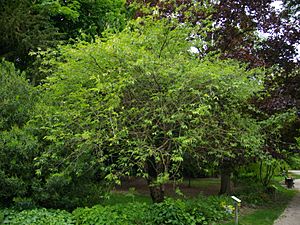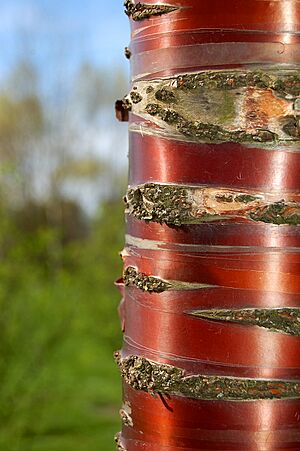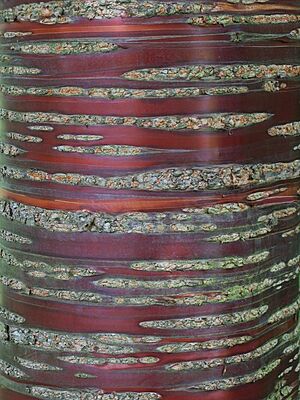Prunus serrula facts for kids
Quick facts for kids Prunus serrula |
|
|---|---|
 |
|
| Growth form | |
| Scientific classification | |
| Synonyms | |
|
The Tibetan cherry (scientific name: Prunus serrula) is a special type of cherry tree. It's also known as the birch bark cherry or paperbark cherry. This tree comes from China. People all over the world love to plant it because of its amazing bark. The bark is a shiny coppery-red color, which makes it stand out, especially in winter!
Contents
Discovering the Tibetan Cherry Tree
What Does It Look Like?
The Tibetan cherry is a small tree that loses its leaves in autumn. It often grows with several trunks instead of just one. These trees can reach a height of about 6 to 9 meters (20 to 30 feet).
Its leaves grow one after another along the branch. They are simple, meaning they are not divided into smaller leaflets. Each leaf is about 5 to 10 centimeters long and 1.5 to 2.0 centimeters wide. The edges of the leaves are serrated, which means they look like tiny saw teeth.
The Amazing Bark
The most famous part of this tree is its bark. It's smooth and has a beautiful brownish-red color. You'll notice clear horizontal lines on the bark called lenticels. These are like tiny pores that help the tree breathe. The outer layer of the bark is incredibly strong. It's almost as tough as a special plastic called Mylar!
Flowers and Fruit
The Tibetan cherry tree produces pretty flowers, just like other cherry trees. They usually grow in small groups of one to three flowers. After the flowers, the tree grows small, oval-shaped fruits. These fruits are bright red and are a type of drupe, which means they have a hard pit inside, like a peach or a plum.
Growing Tibetan Cherry Trees
Where Do They Grow Best?
People plant the Tibetan cherry tree mainly for its beauty. It's especially popular in winter when its colorful bark really shines. This tree is quite flexible and can grow in many different types of soil. It also tolerates a wide range of soil acidity (pH levels).
It loves to be in full sunlight. The tree grows well in areas with moderate winters, specifically in USDA hardiness zones 5 to 8. This means it can handle temperatures down to about -23 to -29 degrees Celsius (-10 to -20 degrees Fahrenheit).
Keeping Them Healthy
The Tibetan cherry tree is not usually considered an invasive species. This is because it can get sick from many common garden diseases and pests. For example, it can be affected by fire blight, a bacterial disease, or powdery mildew, a fungal disease. Japanese beetles also like to munch on its leaves.
Sometimes, growers will graft the Tibetan cherry onto the top part of a Japanese cherry tree. This creates a tree with the beautiful red bark of the Tibetan cherry and the showier flowers of the Japanese cherry.
In 2012, a special type of Tibetan cherry called 'Branklyn' won an important award. It received the Royal Horticultural Society’s Award of Garden Merit. This award means it's an excellent plant for gardens.



